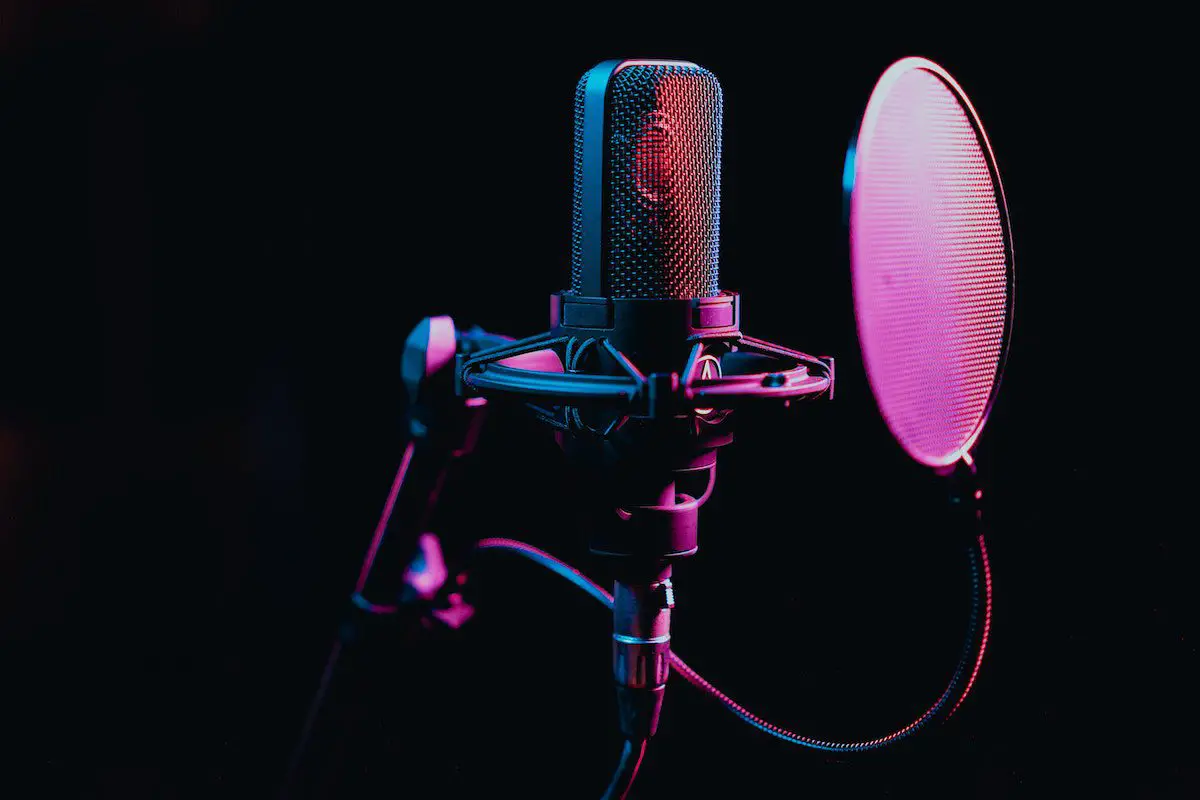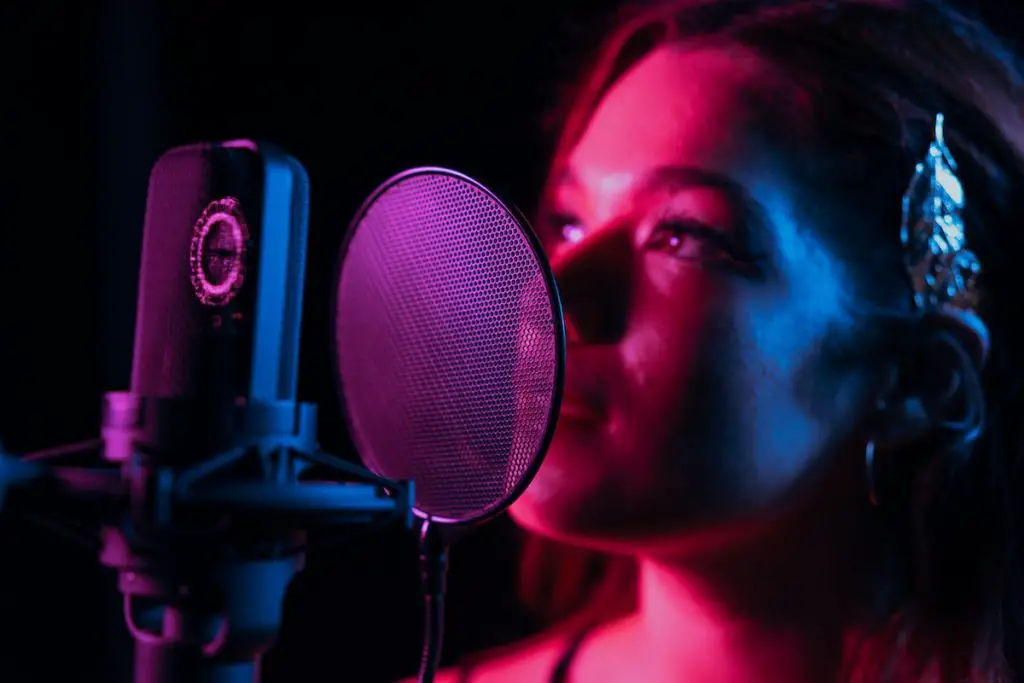Picture this: you’re in your home studio, vibing to your latest track. You lean into your mic, feeling the rhythm, and then – POP! The explosive sound of a plosive punctuates your pristine recording. Your once smooth, sultry vocal now resembles a popcorn machine. Not exactly the chart-topper vibe you were going for, huh?
So, what’s the antidote to this audio ailment? Enter the hero of our tale: the pop filter. The unsung hero of recording sessions, this trusty tool might just be your new best friend. But what exactly is a pop filter, and how does it go from zero to hero in the blink of an eye? This blog post is going to hit the right note on that, shedding light on this ‘pop’ular studio sidekick.
What is a pop filter in audio? A pop filter, in the realm of audio, is a screen placed between a microphone and a vocalist to reduce or eliminate popping sounds caused by the mechanical impact of fast-moving air on the microphone during recorded speech and singing.
What exactly is a pop filter?
A pop filter, or a pop shield as some call it, is a noise protection tool for microphones. As much as we love to pop bottles in the studio, we don’t want any ‘popping’ sounds in our recording. It’s like that unwanted guest crashing your party, right?

Pop filters are typically made of either metal or fabric mesh, stretched across a circular frame. They’re like the bouncers of your audio club, catching those fast-moving air blasts before they can hit the mic and cause havoc. Imagine you’re rapping your heart out, and you hit a hard ‘P’ or ‘B’ sound. That’s when our friend, the pop filter, steps in, blocking those plosive sounds and saving your mix from any unwanted ‘pop’arazzi.
To put this into perspective, picture a vocalist (let’s call him Mike) recording his new track. When Mike belts out a line with a lot of plosives, like “Peter Piper picked a peck of pickled peppers,” without a pop filter, his recording would sound more like a firework show than a hit song.
…in the grand symphony of audio production, the pop filter plays a vital role. It might not be center stage, but it’s working its magic behind the scenes…
But when Mike uses a pop filter, it’s smooth sailing. The filter diffuses the energy from the plosives, eliminating the harsh “pop” sound. Mike’s track is now clean, clear, and ready to top the charts.
But it’s not just about plosives. Pop filters also keep moisture off your mic. Picture this: you’re in the studio, laying down a vocal track. It’s intense, you’re into it, and let’s be real – you’re probably spitting a little. Over time, this moisture can damage your mic, and trust me, that’s a repair bill you don’t want.
Here’s a quick rundown of why you should be reaching for that pop filter:
- Plosive protection: Keep those hard ‘P’ and ‘B’ sounds in check.
- Moisture control: Keep your mic dry and happy.
- Improved audio quality: Give your recording a professional edge.
Here are some dos and don’ts of using pop filters:
| Do | Don’t |
|---|---|
| Do position your pop filter about 2-3 inches from the microphone | Don’t put it directly against the mic |
| Do use a pop filter when recording vocals | Don’t use it for instrumental recordings |
| Do clean your pop filter regularly | Don’t ignore signs of wear and tear |
So, in the grand symphony of audio production, the pop filter plays a vital role. It might not be center stage, but it’s working its magic behind the scenes, helping you create a flawless recording.

AKAI Professional MPK Mini MK3

AKAI Professional MPK Mini MK3
What’s the science behind pop filters?
Pop filters work by dispersing the air pressure that causes plosive sounds. When you make a ‘P’ or ‘B’ sound, you’re basically creating a mini air explosion towards the mic. The pop filter acts like a superhero, swooping in to diffuse this pressure before it hits the microphone diaphragm and causes distortion.
Let’s get visual for a moment. Imagine your favorite vocalist is in the studio, singing a song with a lot of plosive sounds. Without a pop filter, every ‘P’ and ‘B’ is like a mini sonic boom hitting the mic. But put a pop filter in the mix, and it’s like having a shield deflecting those booms, spreading the air pressure out, and keeping the mic safe from distortion.
But wait, there’s more! Pop filters also create a physical space between the vocalist and the microphone. This space helps reduce the proximity effect – the bass boost that happens when you’re too close to the mic. So, not only does a pop filter protect your recording from plosives, but it also helps keep your bass levels in check.
So, here’s the science-y stuff in a nutshell:
- Air pressure diffusion: Pop filters spread out the air pressure from plosives, preventing distortion.
- Proximity effect reduction: The space a pop filter creates between the vocalist and the mic helps balance bass levels.
Pop filters are the unsung heroes of the studio, using some cool science tricks to keep your recordings sounding smooth and professional. It’s all about creating that perfect mix, and a pop filter is a key ingredient in that audio recipe.
What are some popular pop filters in the market?
The table below provides a comprehensive comparison of some of the most popular pop filters currently available in the market. Each product is evaluated based on its materials, diameter, gooseneck length, and average customer rating.
The material of the pop filter can impact the quality of sound, and the diameter and gooseneck length affect the flexibility of use. This detailed comparison aims to help you choose the best pop filter according to your specific needs.
| Product Name | Material | Diameter (in inches) | Gooseneck Length (in inches) | Avg. Customer Rating (out of 5) |
|---|---|---|---|---|
| Aokeo AK-15 | Metal Mesh | 6 | 14.5 | 4.5 |
| Heil PR-40 | Nylon Mesh | 5.5 | 12 | 4.3 |
| Aokeo AK-35 | Double Layer | 6 | 15 | 4.6 |
| InnoGear IG-57 | Metal Mesh | 6 | 14 | 4.4 |
| Neewer NW(B) | Nylon Mesh | 5 | 13 | 4.2 |
| Heil PR-30 | Nylon Mesh | 5.5 | 12 | 4.1 |
Advantages and disadvantages of pop filters in audio
Pop filters, or pop shields, are common fixtures in recording studios, frequently seen attached to microphones. They serve a vital function in audio recording, but like any tool, they come with their own set of advantages and disadvantages. Let’s delve into this in a bit more detail to help you make an informed decision about using pop filters in your audio setup.
Advantages of pop filters
Now, let’s look at the brighter side, the advantages that come with using pop filters.
- Reduced Plosive Sounds: Pop filters reduce plosive sounds, those harsh “P” and “B” sounds that can cause distortion and disrupt the audio recording quality.
- Protection for Microphone: They help in extending the lifespan of your microphone by blocking saliva or spit that could potentially harm the microphone during close proximity speaking or singing.
- Improved Voice Clarity: By diffusing the air from vocal plosives, pop filters help in maintaining the clarity and consistency of the voice being recorded.
- Affordability: Pop filters are generally inexpensive and can be a cost-effective addition to enhance the audio recording quality.
- Versatility: They are versatile and can be used with a variety of microphones, making them a flexible choice for different recording environments.
Disadvantages of pop filters
However, there are also some downsides that we need to consider when using pop filters.
- Potential Sound Alteration: While pop filters reduce plosives, they might slightly alter the sound of the voice being recorded, which some audio purists might not prefer.
- Setup Complications: They can add to the complexity of your setup. Attaching, adjusting, and positioning the pop filter can be a little tricky and time-consuming.
- Space Consumption: Especially in smaller recording environments, pop filters can consume valuable space.
- Visual Distraction: For live performances or video podcasts, a pop filter could be visually distracting or obstruct the view of the performer.
- Maintenance Required: Pop filters require regular cleaning to keep them in optimal condition and ensure they don’t negatively impact your sound quality over time.
Remember, while pop filters have their pros and cons, the choice to use one will largely depend on your specific needs and the nature of your audio recording environment.
If you want even more tips and insights, watch this video called “Do you need a pop filter?” from the Dark Corner Studios YouTube channel.
Frequently asked questions (FAQ)
Do you still have questions about a pop filter? Below are some of the most commonly asked questions.
Do I need a pop filter for podcasting?
Absolutely! Podcasting involves a lot of talking, which means a lot of potential for plosive sounds. A pop filter will help keep your audio clear and professional.
Are there different types of pop filters?
Yes, there are. The two most common types are metal and fabric, each with its own pros and cons. Metal pop filters are more durable and easier to clean, while fabric filters are often more affordable.
Can I make a DIY pop filter?
While it’s possible to create a makeshift pop filter using materials like a wire hanger and nylon stockings, a professional pop filter will provide better results and last longer.
Can I record without a pop filter?
Yes. While using a pop filter is generally recommended for professional audio recording to achieve cleaner and clearer sound, it is not an absolute requirement.
Alternative techniques such as adjusting the microphone placement, using a technique called off-axis recording, or employing post-processing tools can help mitigate the impact of plosive sounds and reduce the need for a pop filter. However, using a pop filter remains a widely accepted and effective method to prevent plosive sounds and achieve high-quality audio recordings.
Conclusion
And there you have it, audio architects! We’ve gone on a sonic journey, exploring the who, what, why, and how of pop filters in audio production. It’s been quite a ride, hasn’t it? Remember, a good recording is like a good mixtape – it’s all about the right balance. And a pop filter? That’s your secret weapon for keeping those ‘P’s and ‘B’s from going pop and locking your audio quality. So, keep your tracks popping in the right way, and remember to always protect your mic – after all, it’s your partner in rhyme!
Did my breakdown hit the right note? And did I cover everything you wanted to know? Let me know in the comments section below – I read and reply to every comment. If you found this article helpful, share it with a friend, and check out my full blog for more tips and tricks on audio production. Thanks for reading, and keep those beats banging!
Key takeaways
This article covered pop filters in audio production. Here are some key takeaways:
- A pop filter is a tool used in audio recording to eliminate ‘popping’ sounds caused by fast-moving air hitting the microphone, known as plosives.
- Pop filters are typically made of either metal or fabric mesh and are positioned a few inches away from the microphone.
- Pop filters not only protect against plosive sounds but also help keep moisture off the microphone, potentially extending the life of your equipment.
- The science behind pop filters involves dispersing air pressure that causes plosive sounds and reducing the proximity effect, helping balance the bass levels in a recording.















